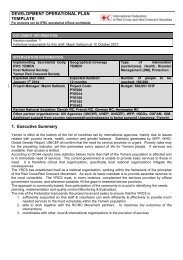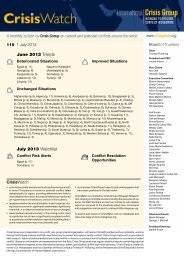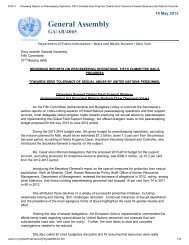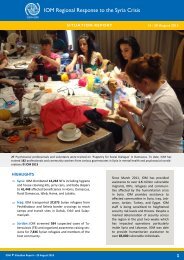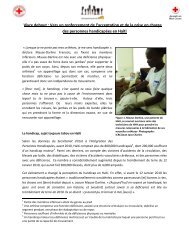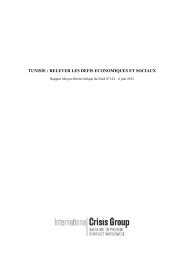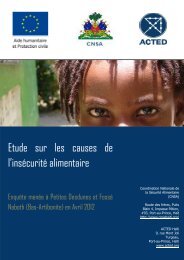SOMALI NUTRITION STRATEGY 2011 – 2013 - ReliefWeb
SOMALI NUTRITION STRATEGY 2011 – 2013 - ReliefWeb
SOMALI NUTRITION STRATEGY 2011 – 2013 - ReliefWeb
Create successful ePaper yourself
Turn your PDF publications into a flip-book with our unique Google optimized e-Paper software.
As highlighted in the situation analysis young child feeding practices in Somalia tend to be<br />
inadequate, with only one in ten children being appropriately fed. Energy density of complementary<br />
feeds is low and diet diversity poor. A recent review of 42 efficacy trials and effectiveness studies on<br />
complementary feeding interventions concluded that carefully designed programmes that include<br />
pre-tested educational messages provided through multiple channels had an effect in improving<br />
complementary feeding. A greater impact was seen when animal-source foods were specifically<br />
promoted in the messages or when food supplements were provided as well. Educational strategies<br />
should focus on imparting the knowledge and develop skills to maximise use of locally-available,<br />
high-quality foods, as well as food safety, cultural beliefs and intra-family food distribution. As<br />
recommended in the review, this strategy aims to deliver nutrition counselling through multiple<br />
channels, individual, community and mass media integrated into the programmes that reach mothers<br />
and children ie nutrition programmes, schools, community based initiatives and MCH and outreach<br />
services. The integration of support for IYCF into the CMAM approach, piloted in Sierra Leone and<br />
Zimbabwe by UNICEF & Save the Children UK may be a useful model to adapt to Somalia.<br />
63<br />
Outcome 4 Improved availability and coverage of micronutrients and de-worming<br />
interventions to the population<br />
Micronutrient malnutrition has wide-ranging effects on health, learning ability and productivity and<br />
has high social and public costs leading to reduced work capacity due to high rates of illness<br />
and disability. As highlighted in the situational analysis, prevalence of both nutritional anaemia and<br />
vitamin A deficiency in women and children in all three zones of Somalia are above WHO thresholds<br />
for the classification of a severe situation.<br />
There are different approaches to preventing micronutrient malnutrition. The best way is to ensure the<br />
consumption of a balanced diet but this requires universal access to adequate food and appropriate<br />
dietary habits, neither of which reflect the current scenario in Somalia, and both of which are<br />
complex and long term issues to address. In the shorter term, micronutrient supplementation and<br />
food fortification and deworming have been proven both highly effective and low cost interventions.<br />
With their high benefit to cost ratio, these interventions have been identified as among the top ten<br />
cost-effective solutions to global challenges (Copenhagen Consensus 2008).<br />
In Somalia, bi annual vitamin A supplementation and deworming are currently key components<br />
of child health days, multiple micronutrient supplementation for pregnant and lactating women<br />
is available through MCH. Activities identified in this strategy aim to strengthen these existing<br />
interventions and to develop new approaches to increase coverage through novel population based<br />
strategies eg through schools and nutrition programme beneficiaries.<br />
Another novel approach identified in this strategy is the fortification of food, in particular cereal<br />
flours. Food fortification is able to deliver nutrients to the population without requiring changes in<br />
food consumption patterns. It is usually socially acceptable, requires no change in food habits, can<br />
produce nutritional benefits for the target population quickly and is a safe, cost-effective way of<br />
reaching large target populations (WHO FAO Guidelines on Food Fortification with Micronutrients<br />
2006). Also food fortification can provide nutrients that are not obtainable in sufficient doses from<br />
local foods, such as folic acid for the prevention of birth defects. This new area for Somalia will<br />
require preliminary work before going to scale. With nearly half the population receiving humanitarian<br />
food assistance, the fortification of grains distributed through the general food ration is a priority.<br />
Furthermore as even in a good year, Somalia imports 60% of its cereal requirement, fortification<br />
of imported cereal flours presents an important vehicle for improving the micronutrient intake of a<br />
significant proportion of the population. Fortification of flour at the community level may be a useful<br />
approach in low access areas.




